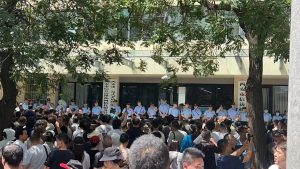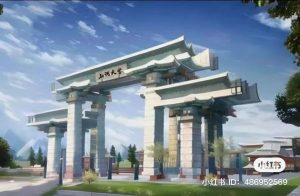According to its official website, The University of Mountains and Rivers (or Shan He Da Xue 山河大学, or SHU) is located on No.1 Shan He Road, in a special administrative region where China’s four northern provinces, Shandong 山东, Shanxi 山西, Henan 河南, and Hebei 河北 intersect. The name Shanhe is a portmanteau of the four provinces, the names of which literally mean ‘east of the mountain’, ‘west of the mountain’, south of the river’ and ‘north of the river’ respectively. In 2023, SHU plans to admit a total of 3.5 million students, out of which 500,000 will be given full scholarships. Unlike other universities where students have to live in dormitory rooms of four to six people sharing communal baths and toilets, students attending SHU will live in air-conditioned, two person rooms, each with its own bathroom and toilet. Although a new university, SHU has ambitions to surpass China’s two most prestigious universities, Tsinghua University by 2026, and Peking University by 2028. Moreover, a draft version of the university charter emphasises democratic rule, stating that ‘all members of the university are equal and administrators must not exercise power arbitrarily.’
This university took just twenty-four hours to build. Planning started one day in late June with a post on China’s major social media sites claiming that if every one of the some 3.43 million year twelve students from the provinces of Shandong, Shanxi, Henan and Hebei were to donate 1000 yuan each (roughly AU$200), then there would be enough money – 3.43 billion yuan (roughly AU$ 73.1 million) – to fund a new university. [1]
The post surfaced at a time when China’s high-school students, having survived the gruelling National Higher Education Entrance Examination (known colloquially as the gaokao) earlier that month, were applying for universities. What started as a light-hearted joke soon became a channel for students who felt locked out of China’s extremely competitive university admissions system to express their grievances.
Within a day, a website for the university was launched, designs and mottos were selected for the university’s logo, followed by drawings of the university’s main gates and dormitories. There was even a mouth-watering menu for the university canteen. Twenty-four faculties were created, offering over 430 majors, from standard STEM courses to niche subjects like pickle-making. The Tang dynasty poet Du Fu 杜甫, an illustrious native of Henan province, was chosen as the university’s first honorary vice chancellor. In the autumn of 761, after a wild storm had destroyed the roof of his straw hut, leaving his family shivering through the cold night, Du Fu penned lines that all Chinese schoolchildren now learn by rote:
If one could have a great house of a million rooms —
Sheltering all the empire’s shivering scholars, their faces lit up with joy —
A house not shaken by wind or rain, solid as a mountain —
Alas! When shall I see that house stand before my eyes?
Then, even if my own hut was destroyed, and I might freeze and die, I should be satisfied. [2]
For the creators of SHU, this verse of Du Fu’s perfectly encapsulates the goal of this fictional university, which, as a mock admission brochure makes it clear, is to ‘lift all students from the injustice they face, and to ensure every student from the four provinces has the opportunity to attend university.’ The injustice refers to the relative scarcity of higher education opportunities in the provinces of Shandong, Shanxi, Henan and Hebei, despite these provinces having some of the largest student populations in China. In 2023, the number of students from the four provinces made up about a quarter of the 12.91 million students taking the gaokao. And yet, the four provinces only house two of China’s thirty-nine elite universities (collectively known as ‘985 universities’, based on the date when the central government announced the building of a number of world-class universities in May – the fifth month – 1998). Both elite universities are located in Shandong, China’s second largest province. China’s third, sixth and eighteenth largest provinces (Henan, Hebei and Shanxi) do not have a single elite university. In comparison, a combined total of 100,000 students from Beijing and Shanghai sat gaokao this year, roughly 0.8 percent of the national total, and yet there are twelve elite universities in Beijing and Shanghai, nearly a third of the thirty-nine elite universities.

Mock SHU admission brochure. (Source: China Digital Times)
Because universities in China have admission quotas favouring local students, having a higher concentration of elite universities in places like Beijing and Shanghai means that students whose household registration or hukou 户口 is in one of these cities face much less competition. A study based on university admissions data from 2020 found that in order to be admitted into either Peking University or Tsinghua University (both located in Beijing), a student in Beijing had 48,450 competitors, while a student in Henan faced 1,157,600 competitors, making admission twenty-four times less likely.
A similar admissions system linked to one’s hukou exists for China’s high school entrance exam. In July this year, this triggered an angry protest in Xi’an province by parents of middle-schoolers against ‘returning students’ 回流生, that is, students who have studied in other parts of China, but returned to Xi’an where their hukou is located to compete with local students for admission to a good high school. In rumours circulating before and during the protest, parents have claimed 40,000 out of the 110,000 students that took the high-school entrance exam in Xi’an this year came from the neighbouring Henan province (where competition to get into good high schools is fierce). In response to the protest, an official report claimed that there were only 3,608 ‘returning students’ taking part in this year’s high school entrance exam.

Parents in Xi’an protesting in front of the city’s Public Complaints and Proposals Administration Office. (Source: Twitter)
Inequality in China’s education system is by no means new. A 2013 joke posted on Weibo was funny then as it is now:
In Beijing: ‘Dad, I got a 530 [on the gaokao], 53 points higher than the lowest qualifying score for top-tier universities!’ ‘Great job, son! Let’s go to Shanghai for our vacation!’
In Shandong: ‘Dad, I got a 530, 20 points lower than the lowest qualifying score for second-tier universities!’ ‘You’re not so bright … Don’t go [to college]. Get out of here and go become a migrant worker in Shanghai.’
In Shanghai: ‘Dad, I got a 330. Send me abroad.’ ‘Okay, son. Go get an MBA, then come back and help me. I got another group of migrant workers from Shandong this year.’ [3]
A decade later, this joke appears even closer to life given China’s rising youth unemployment rate. The difference is that it was still permitted to discuss the education gap openly back then. When former premier Wen Jiabao 温家宝 expressed his concern at seeing fewer students from a rural background attending universities and vocational colleges in 2009, it was headline news on Xinhua News, China’s official state news agency. In comparison, even though it was a joke, discussions relating to SHU were quickly censored on China’s major social media platforms and the mock website was shut down. When reporters brought up the topic during a press conference, Deputy Education Minister Wu Yan吴岩 responded with impenetrable officialese, promoting netizens to comment that AI could have done a better job:
We too have taken notice of the issues concerning ‘Shanhe University’. Faced with the new situation of higher education entering a new stage of popularisation, as well as new challenges and issues in serving regional economic and social development, the Ministry of Education will continually optimise the structure and layout of higher education resources. We will support the central and western regions, especially provinces with large populations, to expand the scale of higher education resources and optimise the type and regional structure…[4]

Draft document related to SHU entitled ‘Regulations on Democratic Management’. (Source: Twitter)
The harsh reality of China’s unequal university admissions system has stopped many students from even dreaming of attending a good university. Instead, they devoted their energy to imagining a university of their dreams. And yet, even as a fantasy, SHU’s vision appears somewhat distorted on a closer examination. Contrary to the humanistic spirit expressed in Du Fu’s poem, creators of SHU have made it extremely difficult for students from outside the four provinces to gain admission, stating that they will need to have scored at least 700 points (out of a perfect score of 750) in their gaokao. Moreover, despite its emphasis on democratic rule, the draft version of the university charter states that, ‘all decisions have to be made through democratic centralism’ 民主集中制, a concept first proposed by Lenin in 1921 and is best ‘translated’ by George Orwell as, ‘all animals are equal, but some animals are more equal than others’. The Communist Party of China (CPC) continues to promote democratic centralism as their guiding principle. After SHU’s prototype website went down, a few new websites sprung up, one even replaced the university’s original motto from ‘erudition’ 博学 and ‘thirst for knowledge’ 求知 with the twelve ‘socialist core values’. Despite what some commentators may say about SHU being a powerful symbol of how people in China can still spontaneously organise online despite heavy censorship, posing a threat to the ruling authority, in truth, the authorities have little to fear. They have already moulded the way Chinese students dream.
Notes
[1] The initial post online made a mathematical mistake and claimed this scheme would raise 34.3 billion yuan.
[2] Translation slightly modified based on Florence Ayscough’s version, accessed online at: https://www.poetrynook.com/poem/thatched-house-unroofed-autumn-gale
[3] Translation by Yiqin Fu in ‘China’s Unfair College Admissions System’, The Atlantic, 19 June 2013, online at: https://www.theatlantic.com/china/archive/2013/06/chinas-unfair-college-admissions-system/276995/
[4] This speech was translated using ChatGPT.



